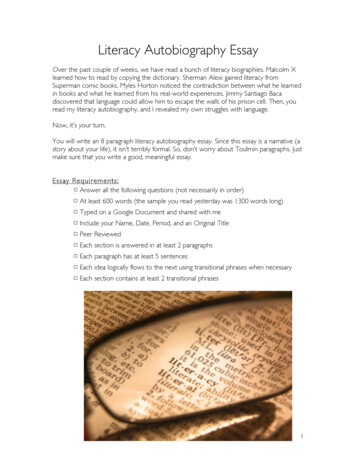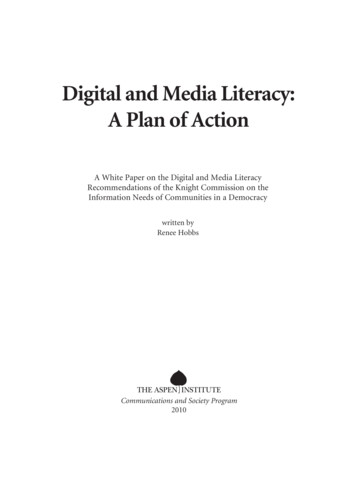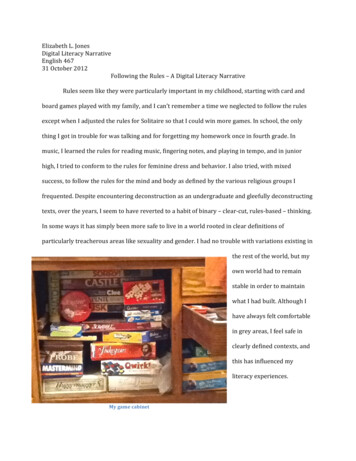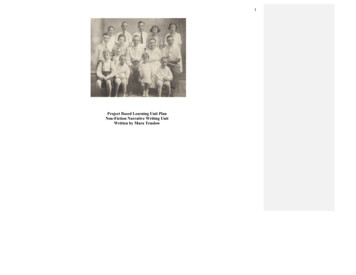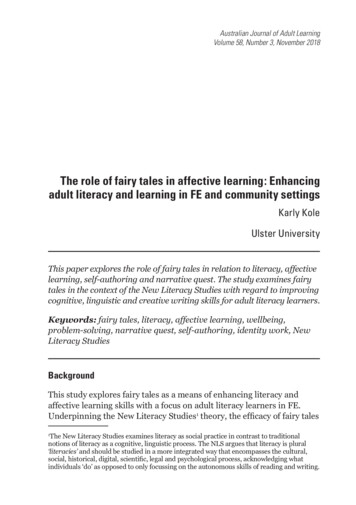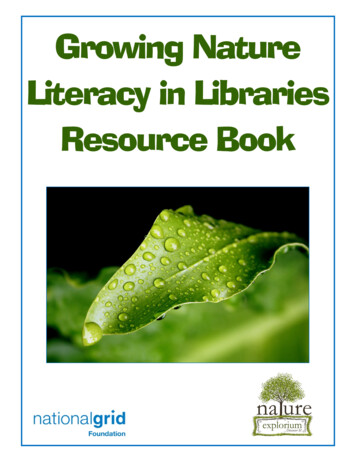
Transcription
Growing NatureLiteracy in LibrariesResource Book
IntroductionIn today's world, there is a growing awareness of the need for children to haveaccess to public places and outdoor learning opportunities that enhance theirwell-being, provide a variety of educationally appropriate formal and informalplay activities, promote a direct experience with nature, and foster a sense ofcommunity and responsibility for the environment. Exposure to nature throughplay leads to exploration and discovery, engaging both the physical and mentalabilities of the child and providing a holistic approach to learning and literacy. Itis hoped that linking the concepts of early education and nature literacy willlead to an understanding and appreciation of the natural world.Public libraries as local community institutions bring together early learning,family-centered practice, nature literacy, sustainable communities and, at thesame time, stay true to their mission for sharing local resources. Outdoorlearning spaces and programs for children, contiguous with the library, serve asanother relevant learning path that takes advantage of the library's publicaccessibility, trained public service staff, and inclusive approach to serving allfamilies in a recreational and educational space. By providing resources forfamilies to connect with nature libraries offer a unique way to connect literacy,learning, and an appreciation for nature as a regular part of the library visit.The "Growing Nature Literacy in Libraries Resource Book" is provided in partnershipwith National Grid Foundation, a supporter of nature literacy.ContentBibliographies .2Internet Resources . . .15Programs . . 16Programmers .21Outdoor Nature Areas on Long Island .22Appendix
BibliographiesPicture Books K – 2nd GradeAliki. Quiet in the Garden. New York: Greenwillow Books, 2009.Sitting quietly in his garden, a little boy observes the eating habits of birds, bugs,butterflies, and other small animals. Includes instructions on how to make your own garden anda detailed illustration of plants typically found in a garden.Arnosky, Jim. At This Very Moment. New York: Dutton Children's Books, 2011.Identifies some of the things happening in nature while one goes about an ordinary day,such as a shark circling a reef while one brushes one's teeth or puffins eating fresh -caught fishwhile one eats dinner.Berenstain, Stan. The Berenstain Bears Grow-It. New York: Random House, 1996.As Brother and Sister help Mama plant seeds in the garden, they discover the importanceof seeds and how they become useful and important plants.Churchill, Ginger. Wild Rose's Weaving. Terre Haute, IN: Tanglewood, 2011.While her grandmother weaves a beautiful rug, Rose plays in a storm, and both find joy inthe beauty that surrounds them.Davis, Nancy. A Garden of Opposites. New York: Schwartz & Wade Books, 2009.Opposites abound in a colorful garden, including a closed bud, an open blossom, a shortcaterpillar, and a long snake.Ehlert, Lois. Growing Vegetable Soup. San Diego: Harcourt Brace Jovanovich, 2009.A father and child grow vegetables and then make them into soup.Ehlert, Lois. Planting a Rainbow. San Diego: Harcourt Brace Jovanovich, 2009.A mother and child plant a rainbow of flowers in the family garden.Falwell, Cathryn. Mystery Vine: A Pumpkin Surprise. New York:Greenwillow Books, 2009.When a mysterious vine appears in their carefully tended garden,a brother and sister patiently watch and wait to see what it becomes.Includes gardening activities and pumpkin recipes.Falwell, Cathryn. Pond Babies. Camden, ME: Down East Books, 2011.Examines some of the different animal babies at the pond, such as a duck,a turtle, and a loon. Includes note to parents on what to do at a pond.Fogliano, Julie. And Then It’s Spring. New York: Roaring Brook Press, 2012.Simple text reveals the anticipation of a boy who, having planted seedswhile everything around is brown, fears that something has gone wrong until,at last, the world turns green.2
Gal, Susan. Into the Outdoors. New York: Alfred A. Knopf Books for Young Readers, 2011.A child describes the wonders observed during a family camping trip to the mountains in a story thatintroduces the reader to prepositions.Henkes, Kevin. My Garden. New York: Greenwillow Books, 2010.After helping her mother weed, water, and chase the rabbits from their garden, a young girl imaginesher dream garden complete with jellybean bushes, chocolate rabbits, andtomatoes the size of beach balls.Kato, Yukiko. In the Meadow. New York: Enchanted Lion Books, 2011.A little girl hears the sounds of nature all around her whenshe follows a butterfly into a meadow.Lawler, Janet. A Mother’s Song. New York: Sterling, 2010.A mother finds special ways to enjoy nature with her childall through the year.Lobel, Anita. 10 Hungry Rabbits: Counting and Color Concepts for the Very Young. New York: Alfred A.Knopf Books for Young Readers, 2012.Ten rabbits are hungry for supper but Mama Rabbit has nothing to put in her soup pot, so Papa sendsthe little ones to the garden where they discover increasing numbers of foods in many different colors.Marshall, Linda Elovitz. Talia and the Rude Vegetables. Minneapolis: Kar-Ben, 2011.City-girl Talia misunderstands her grandmother's request that she go to the garden for"root vegetables" but manages to find some she thinks are rude, as well as a good use for the restshe harvests. Includes a recipe for Rude Vegetable Stew.Mayer, Mercer. A Green, Green Garden. New York: Harper, 2011.Little Critter and his family work on growing a garden, and after planting seeds, watering eachseedling, and waiting for the plants to grow, they have a green garden with lots of vegetables.Parker, Kim. Counting in the Garden. New York: Orchard Books, 2005.Invites the reader to count the inhabitants of a garden, from one to ten, such as four bunniesand nine inchworms.Pfister, Marcus. Questions, Questions. New York: North South, 2011.Poses questions about nature, such as why birds sing and why leaves turn brown.Rao, Lisa. Dora’s Magic Watering Can. New York: Simon Spotlight, 2008.When Dora, Boots, and the twins find a magic watering can, they head to Isa's flowery garden to tryit out.Sayre, April Pulley. Rah, Rah, Radishes!: A Vegetable Chant. New York: Beach Lane Books, 2011.Photographs of vegetables and rhyming text celebrate vegetables in all their colorful and tastyvariety.Sidman, Joyce. Red Sings from Treetops: A Year in Colors. Boston: Houghton Mifflin Harcourt, 2009.Nature displays different colors to announce the seasons of the year.3
Sidman, Joyce. Swirl by Swirl: Spirals in Nature. Boston: Houghton Mifflin Books forChildren, 2011.Celebrates the shape of a spiral in nature, from rushing rivers to flower buds and even the shapeof an ear.Smith, Lane. Grandpa Green. New York: Roaring Brook Press, 2011.A child explores the ordinary life of his extraordinary great -grandfather, as expressed in histopiary garden.Snyder, Betsy. Sweet Dreams Lullaby. New York: Random House Children's Books, 2010.A young bunny goes to sleep and dreams of the soothing colors, shapes, sights, and soundsof nature.Wallace, Nancy Elizabeth. Leaves! Leaves! Leaves! New York: Marshall Cavendish, 2007.During the four seasons of the year Buddy Bear and his mother go "leaf walking" anddiscover a lot of interesting things about leaves.Wallace, Nancy Elizabeth. Planting Seeds. New York: Marshall Cavendish, 2010.Increasing numbers of rabbits plant, tend, harvest, and eat produce from their garden.Wallace, Nancy Elizabeth. Pond Walk. New York: Marshall Cavendish, 2011.One summer day, Buddy and his mother take a walk around a pond and observe theanimals and insects that live there.Wilson, Karma. Mortimer’s First Garden. New York: Margaret K. McElderry Books, 2009.Little Mortimer Mouse, longing to see something green at winter's end, follows the lead ofthe big people and plants, waters, and weeds his last sunflower seed until, finally he harvests hiscrop.Wolff, Ashley. Baby Bear Sees Blue. New York: Beach Lane Books, 2012.Leaving the den as the weather warms, Baby Bear discovers blue birds, red strawberries,orange butterflies, and other colorful things in nature.Wood, Audrey. Blue Sky. New York: Blue Sky Press, 2012.Throughout the day and into the night, a boy and hisfamily observe the constantly changing sky.Wood, Douglas. No One But You. Sommerville, MA: CandlewickPress, 2011.Readers are invited to discover nature using their sense ofsmell, sight, hearing, touch, and taste.Wortche, Allison. Rosie Sprout's Time to Shine. New York: Alfred A. Knopf, 2011.Rosie's rival, Violet, outdoes her in everything until the class plants seeds for a unit on gardening.4
Easy ReadersCapucilli, Alyssa Satin. Biscuit's Earth Day Celebration. New York: HarperFestival, 2010.Biscuit and the little girl take care of the planet through small acts, from planting seeds tocleaning up, as they take part in a celebration of Earth Day.Feldman, Thea. Tucker's Beetle Band. New York: Square Fish, 2011.Tucker Mouse decides to help a beetle band win the Battle of the Bug Bands, but when one of thebeetles is injured, Tucker comes up with an idea to save the day.George, Jean Craighead. Goose and Duck. New York: Laura Geringer Books, 2008.A young boy becomes the "mother" to a goose, who becomes "mother" to a duck, as theylearn about the rhythms of nature together.Inches, Alison. Corduroy's Garden. New York: Viking, 2004.When the beans that Lisa has planted are dug up by a dog,Corduroy reseeds the garden but he and Lisa are in for a surprise whenthe "beans" finally appear on the vines.Klein, Adria F. Max Goes to the Nature Center. Mankato, MN: PictureWindow Books, 2009.Zoe and Max visit the nature center where they see snakes, birds,and butterflies.Koontz, Robin. The Case of the Community Garden. Ednia, MN:Magic Wagon, 2010.When the plants disappear from the community garden,Furlock and Muttson are called to the case. Can they follow theclues to solve the case of the community garden?McKay, Sindy. Garden Crew. Novato, CA: Treasure Bay, 2011.A group of students who call themselves "The Garden Crew"plant and tend a garden and finally have a big feast with all the foodthey have grown.McMullan, Kate. Fluffy Grows a Garden. New York: Scholastic, 2001.Fluffy the guinea pig learns all about growing vegetables when Ms. Day's class plants seeds.McNamara, Margaret. The Garden Project. New York: Aladdin Paperbacks, 2010.Deciding to turn an old sandbox into a small vegetable garden, the students in Mrs.Connor's class have a challenging time convincing a reluctant Neil to participate in theirgardening activities and taste the delicious treats that grow.Rau, Dana Meachen. In the Yard. Minneapolis: Compass Point Books, 2002.As the seasons change, a family shares both fun and chores in their yard.Parish, Peggy. Amelia Bedelia Helps Out. New York: Greenwillow Books, 2005.Amelia Bedelia shows her niece Effie Lou how to follow instructions to the letter as they dust thepotato bugs and sow seeds.5
Rylant, Cynthia. Annie and Snowball and the Pink Surprise. New York: Simon & Schuster Books forYoung Readers, 2010.Annie and her bunny, Snowball, like to grow flowers in Annie's backyard. Can Annie and Henryfigure out a way to get more hummingbirds to come to Annie's garden?Sollinger, Emily. Olivia Plants a Garden. New York: Simon Spotlight, 2011.Olivia is planting a garden and she can't wait to see what blooms from her mystery seeds. Sheknows she'll have the best plant in the entire class.Tremblay, Carole. Floop's Flowers. New York: Alphabet Soup, 2010.Floop invites his friend over for a snack but gets distracted when he goes into the garden to picksome flowers.Willems, Mo. Are You Ready to Play Outside? New York: HyperionBooks for Children, 2008.Friends Elephant and Piggie are playing outside when it startsto rain, and then they must decide what to do.Yee, Wong Herbert. Abracadabra! Magic with Mouse and Mole.Boston: Houghton Mifflin, 2007.Mole is mad about magic until he takes his friend Mouse to ashow that turns out to be all tricks, but then Mouse conjures up aspecial night program to show him the enchantment found in nature.Zappy, Erica. Curious George Plants a Seed. Boston: HoughtonMifflin, 2007.When Curious George sees Jumpy Squirrel burying an acorn,he tries to bury all his food, too. When he learns that not everythingthat is buried will grow, that he begins to understand about plantingseeds.Non-Fiction K - 2nd GradeAnderson, Judith. Once There was a Seed. Hauppauge, NY: Barron's, 2010.Introduces the life cycle of plants, describing how a plant is grown from a seed, sprouts roots andleaves, and eventually forms a mature plant or flower which contains new seeds.Bodach, Vijaya. Seeds. Mankato, MN: Capstone Press, 2007.Simple text and photographs present the seeds of plants, how they grow and their uses.Castellucci, Cecil. Grandma's Gloves. Somerville, MA: Candlewick Press, 2010.When her grandmother, a devoted gardener, dies, a little girl inherits her gardening gloves andfeels closer to her memory.Charles, Prince of Wales. Harmony: A Vision for Our Future. New York: Harper Collins Publishers,2010.Offers a call to action for young readers to work together in order to change the direction ofenvironmental crisis by taking steps to live in careful harmony with nature.6
Cleary, Brian P. Green Beans, Potatoes, and Even Tomatoes: What is in the Vegetable Group?Minneapolis: Millbrook Press, 2011.Explains what vegetables are, identifies varieties of vegetables, and details the health benefits ofeating them.Davies, Nicola. Outside Your Window: A First Book of Nature. Somerville, MA: Candlewick Press, 2012.An illustrated treasury of poems reflects the experiences of children as they encounter nature forthe first time.Gibbons, Gail. The Vegetables We Eat. New York: Holiday House, 2007.Illustrations and simple text describe the various vegetables people eat.Green, Jen. Why Should I Protect Nature? Hauppauge, NY:Barron's Educational Series, 2005.Simple text and pictures illustrate the importance ofprotecting nature.Galbraith, Kathryn Osebold. Planting the Wild Garden. Atlanta:Peachtree Publishers, 2011.Shares the ways wind, water, and birds disperse seeds tocreate the wild garden.Koontz, Robin. Composting: Nature's Recyclers. Mankato, MN:Picture Window Books, 2007.Describes how a compost heap operates, what it needs to work well, and what plants, insects, andbacteria help to break down the organic refuse found in one.Munro, Roxie. Hatch! Tarrytown, NY: Marshall Cavendish Children, 2011.Describes and identifies nine birds, their eggs and nests.Peterson, Cris. Seed, Soil, Sun: Earth's Recipe for Food. Honesdale, PA: Boyds Mills Press, 2010.Introduces children to the subject of agriculture, showing not only how plants germinate, grow andproduce food, but also about the composition of soil and the creatures who live in it.Rustad, Martha E. H. Fall Leaves: Colorful and Crunchy. Minneapolis: Millbrook Press, 2012.Discusses the life cycle of leaves, describes how they change color in the fall, and providesinstructions for an autumn art project.Spohn, Rebecca. Ready, Set, Grow!: A Kid's Guide to Gardening. Tuscon: GoodYear Books, 2007.Provides instructions for indoor and outdoor gardening projects, as well as recipes and ideas forcrafts using garden produce.Stewart, Melissa. A Place for Frogs. Atlanta: Peachtree Publishers, 2010.A fact-filled, colorful look at the amazing world of frogs including a call to action to protect thesefascinating creatures.Tagliaferro, Linda. Birds and Their Nests. Mankato, MN: Capstone Press, 2006.Simple text and photographs describe birds and the nests in which they live.7
Wade, Mary Dodson. Flowers Bloom! Berkeley Heights, NJ: Enslow Elementary, 2009.Presents basic information about flowers, including colors, shapes, sizes, and parts.Wade, Mary Dodson. Seeds Sprout! Berkeley Heights, NJ: Enslow Elementary, 2009.Presents information about seeds, including where they come from, how they grow, and how theytravel.Wallace, Nancy Elizabeth. Rocks! Rocks! Rocks! Tarrytown, NY: Marshall Cavendish Children, 2009.When Buddy Bear and his mother go to the Rock Ridge Nature Center, she teaches him all aboutrocks, including the different types, everyday uses, and the causes of erosion.Wilkes, Angela. First Garden Activity Book. London: Dorling Kindersley, 2008.Features simple gardening projects from collecting seeds to growing a miniature desert garden.3rd – 5th Grade FictionBeard, Darleen Bailey. Annie Glover is Not a Tree Lover. New York: Farrar Straus Giroux, 2009.When her grandmother chains herself to the tree across from the school to save it from being cutdown, fourth-grader Annie wants to die of humiliation but when she discovers the town's history, herattitude changes.Corwin, Jeff. Your Backyard is Wild. New York: Puffin Books, 2009.Budding naturalists Lucy and Benjamin are used to seeing fascinating animals and plants inthe Florida Everglades where they live, but they can't imagine what they will find when they visittheir cousin Gabe's New York City backyard.French, Susannah T. Operation Redwood. New York: Amulet Books, 2011.In northern California, Julian Carter-Li and his friends, old and new,fight to save a grove of redwoods from an investment company that plans to cutthem down.Glass, Calliope. Fairy Flora: A Garden-Talent's Guide to the Plants ofPixie Hollow. New York: Disney Press, 2010.Iris, a garden fairy, describes the duties of the garden fairies and theuses for the various plants in Pixie Hollow.Harper, Charise Mericle. Just Grace Goes Green. Boston: Houghton MifflinBooks for Children, 2009.Just Grace uses her empathy superpower to figure out ways tomake her best friend feel better, and she makes a difference for theenvironment too.Havill, Juanita. Grow: A Novel in Verse. Atlanta: Peachtree, 2011.Two misfit children and other members of a Minneapolis, Minnesota, neighborhood arebrought together by a woman creating a community garden.Hermes, Patricia. Emma Dilemma, the Nanny, and the Secret Ferret. Tarrytown, NY:Marshall Cavendish Children, 2010.Emma struggles with finding the perfect time to confess to her parents that she brought herpet ferret on vacation to Maine, and trying to save her favorite tree that a new neighbor wants tocut down.8
Kelly, Jacqueline. The Evolution of Calpurnia Tate. New York: Henry Holt and Co., 2011.In central Texas in 1899, eleven-year-old Callie Vee Tate is instructed to be a lady by hermother, learns about love from the older three of her six brothers, and studies the natural worldwith her grandfather, the latter of which leads to an important discovery.Kurtz, Jane. Lanie. Middleton, WI: American Girl Publishing, 2010.Lanie Holland, loves science and nature, wants to go camping and explorethe wilderness, while her family wants to stay home. Luckily Lanie findssomeone else who loves the outdoors when her Aunt Hannah visits.Leach, Sara. Jake Reynolds: Chicken or Eagle? Custer, WA: Orca Book Publishers, 2009.Eleven-year-old Jake Reynolds wants to save seal pups from thetalons of bald eagles, protect his little sister Sierra and confront the wolfhe is sure stalks Hidalgo Island. When Jake leads his best friend, Emily, intothe woods in search of adventure, he discovers things abouthimself that he never knew existed.Lindman, Maj. Flicka, Ricka, Dicka Go to Market. Chicago: Albert Whitman,2011.Three little Swedish girls cultivate a big vegetable garden, sell their cropseach Saturday at the market, and earn money for bicycles.Lindner, Simone. Amar, the Earth Fairy. New York: Minedition/Penguin Young Readers Group,2008.Amar is a happy-go-lucky little fairy. He knows that plants are powerful and have theamazing ability to heal. When he encounters Coron, a lost and injured little mole, can Amar usethis power in order to help him?Look, Lenore. Alvin Ho: Allergic to Camping, Hiking, and Other Natural Disasters. New York:Schwartz & Wade Books, 2009.When Alvin's father takes him camping to instill a love of nature, like that of theirhome-town hero Henry David Thoreau, Alvin makes a new friend and learns that he can be bravedespite his fear of everything.Milway, Katie Smith. The Good Garden: How One Family Went From Hunger to Having Enough .Toronto, ON; Tonawanda, NY: Kids Can Press, 2010.After Maria Duartes' father leaves the farm to find work, she must plant next year's crop.Her teacher instructs her on how to terrace the land and use compost to improve hergarden so that her family can have enough food for the coming year.Moulton, Erin E. Flutter: The Story of Four Sisters and an Incredible Journey. New York: PhilomelBooks, 2011.Nine-and-a-half-year-old Maple and her older sister, Dawn, must work together to facetreacherous terrain, wild animals, and poachers as they trek through Vermont's Green Mountainsseeking a miracle for their prematurely-born sister.Newbery, Linda. Lucy and the Green Man. New York: David Fickling Books, 2010.Lucy looks everywhere for Lob, the magical man who helps her grandfather with thegarden, even though no one else believes in him, and when her grandfather dies, she worriesabout what Lob will do without him.9
Potter, Ellen. The Humming Room. New York: Feiwel and Friends, 2012.Twelve-year-old orphan Roo Fanshaw, sent to live with an uncle she never knew in a largelyuninhabited mansion on Cough Rock Island, discovers a wild river boy, an invalid cousin and themysteries of a hidden garden.Rocklin, Joanne. One Day and One Amazing Morning on Orange Street. New York: Amulet Books, 2011.The last remaining orange tree on a Southern California street brings together neighbors of all ages asthey face their problems and anxieties, including the possibility that a mysterious stranger is a threat to theirtree.Stauffacher, Sue. Special Delivery! New York: Alfred A. Knopf, 2010.Ten-year-old Keisha and her family's animal rescue center face more challenges involving ababy crow in a mailbox and a skunk found in the nearby communitygarden.Warner, Gertrude Chandler. The Garden Thief (The Boxcar ChildrenMysteries #130). Park Ridge, IL: Albert Whitman, 2012.Helping Grandfather's friend, Mr. Yee, who has broken his armand cannot tend a beloved vegetable plot, the Alden children begininvestigating when they discover that vegetables have gone missing andthat someone is vandalizing the garden.Warner, Gertrude Chandler. The Mystery of the Traveling Tomatoes(The Boxcar Children Mysteries #117). Morton Grove, IL: AlbertWhitman & Co., 2011.The Alden children are helping grow vegetables in a restaurantowner's garden, but when the tomato plants are moved from theiroriginal position the children begin to suspect that the move is connectedto a robbery at the local bank.Non-Fiction 3 rd – 5th GradeAnton, Carrie. The Cutest Nature Book Ever!: Your Guide to Crafting, Daydreaming, Writing, and Thinkingin the Great Outdoors. Middleton, WI : American Girl, 2010.Presents a series of ideas for projects using materials such as stones, acorns, flowers, leaves, andsticks, from creating a greeting card, to pressing a flower, to making a rock insect.Bouler, Olivia. Olivia's Birds: Saving the Gulf. New York: Sterling Children's Books, 2011.An eleven-year-old artist shares her enthusiasm about birds through her own text andillustrations, and suggests ways in which young people can help with the preservation of bird life.Burnie, David. Bird (DK Eyewitness Books). New York: DK Publishing, 2008.A photo-essay on the world of birds examines such topics as body construction, feathers andflight, the adaptation of beaks and feet, feeding habits, courtship, nests and eggs, and bird watching.Cusick, Dawn. Animal Eggs: An Amazing Clutch of Mysteries & Marvels! Waynesville, NC: Early LightBooks, 2011.Explores the different types of animal eggs, from insects to reptiles, fish, and birds, anddescribes how different adult animals care for their eggs and the strange places they place them.10
Earley, Chris G. Birds A to Z. Richmond Hill, ON.: Firefly Books, 2009.Presents alphabetically arranged entries, with information about various types of birds,describing such creatures as the hummingbird, duck, ibis, nighthawk, pelican, woodpecker andyellowleg.Finch, Jenny. Encyclopedia of Nature. New York: DK Publishing, 2009.An encyclopedia of the natural world covers the processes and life forms of the naturalworld, including ecology, cells, classification, and over one hundred individual species of plants andanimals.Gaarder-Juntti, Oona. What in the World is a Green Garden? Edina, MN: ABDO Publishing, 2011.Introduces the environmental importance of "green" gardens that require less energy to maintain,and describes how to cultivate a "green" vegetable garden using rain water, compost, and Earth-friendlymaterials.Henry, Sally. Eco Crafts. New York: PowerKids Press, 2011.Provides step-by-step instructions on making crafts using natural andrecycled materials, including plastic bottle bird feeders, CD mobiles, andpressed flower bookmarks.Jones, Jen. Cool Crafts with Seeds, Beans, and Cones: Green Projects forResourceful Kids. Mankato, MN: Capstone Press, 2011.Step-by-step instructions for crafts made from seeds, beans, and conesand information about reusing and recycling.Jones, Jen. Cool Crafts with Flowers, Leaves, and Twigs: Green Projects forResourceful Kids. Mankato, MN: Capstone Press, 2011.Step-by-step instructions for crafts made from flowers, leaves, and twigs and information aboutreusing and recycling.Kirk, Ellen. Human Footprint: Everything You Will Eat, Use, Wear, Buy, and Throw Out in Your Lifetime.Washington, DC: National Geographic, 2011.Shows kids the dimensions of consumption, including diapers worn as a baby, bread eaten in alifetime, and recycled cans, and explains how to create a sustainable way of living.Kochanoff, Peggy. You Can Be A Nature Detective. Missoula, MT: Mountain Press, 2009.Poses questions based on observation of the natural world and then explores the answers,discussing such topics as types of frogs, why leaves change colors, and identifying animal tracks.Krezel, Cindy. 101 Kid-Friendly Plants: Fun Plants and Family Garden Projects. Batavia, IL: Ball Publishing,2008.Youngsters looking to enrich their green thumbs while beautifying their homes will enjoy acomprehensive guide to indoor and outdoor gardening using nontoxic flowers, vegetables, trees, andhouseplants to create herb gardens, rock gardens, and hanging plants.Krezel, Cindy. Kids' Container Gardening: Year-Round Projects for Inside and Out. Batavia, IL: BallPublishing, 2010.An accessible reference for young gardening enthusiasts that shares 18 container gardeningprojects which include gift options, in an illustrated guide that also provides a glossary of terms and aresource list11
Leslie, Clare Walker. The Nature Connection: An Outdoor Workbook for Kids, Families, andClassrooms. North Adams, MA: Storey Publishing, 2010.An interactive workbook chockfull of creative exercises for kids ages 8 to 13. Sure to engage thewhole family in outdoor fun and year-round nature activities.Locker, Thomas. Rachel Carson: Preserving a Sense of Wonder. Golden, CO: Fulcrum Publishing, 2004.A biography of Rachel Carson interspersed with her own memorable quotes.Preszler, June. Meat-Eating Plants and Other Extreme Plant Life. Mankato, MN: Capstone Press, 2008.Describes the world of plants, including characteristics, life cycles and where they live.Rene, Ellen. Investigating How Flowers Grow. Mankato, MN: Capstone Press, 2008.Describes how flowers reproduce and grow, discussing the parts of a flower, pollen, carbondioxide, photosynthesis, and the role of insects in pollination.Rene, Ellen. Investigating Why Leaves Change Their Color. New York: PowerKids Press, 2009.Explains why leaves change color in the fall, discussing photosynthesis,chlorophyll, leaf pigments, and which trees turn which colors.Spinelli, Eileen. In Our Backyard Garden: Poems. New York: Simon & SchusterBooks for Young Readers, 2004.As one season passes into the next, the backyard garden transformsand different family events are held there, in a colorfully illustrated collection ofpoems.Taylor, Barbara. Inside Plants. New York: Marshall Cavendish Benchmark, 2011.Describes the fascinating plant details that are too small for the unaidedeye to see, and how these microscopic systems work to keep the plant aliveand healthy.Books for Parents & EducatorsBroda, Herbert W. Moving the Classroom Outdoors: Schoolyard-Enhanced Learning in Action. Portland,ME: Stenhouse Publishers, 2011.Designed to provide teachers and administrators with a range of practical suggestions for makingthe schoolyard a varied and viable learning resource. Provided is an outdoor activity sampler andinformation on incorporating technology into the outdoor learning experience.Broda, Herbert W. Schoolyard-Enhanced lLarning: Using the Outdoors as an Instructional Tool, K-8.Portland, ME.: Stenhouse Publishers, 2007.Provides theories, practical suggestions, and activities to help encourage teachers to take advantageof the outdoors as an instructional tool.Casey, Theresa. Environments for Outdoor Play: A Practical Guide to Making Space for Children. London:Paul Chapman, 2007.Exciting spaces to play are vital to provide children with challenging, flexible, inclusive andstimulating opportunities to learn, develop and have fun together. This book provides readers with ideasfor developing play environments that will meet the needs of the children in their care.12
Chalufour, Ingrid. Exploring Water with Young Children. St. Paul, MN:Redleaf Press, 2005.Focuses children’s explorations to help deepen theirunderstanding of water and its properties—including concepts relatedto water’s flow, appearance and effect on objects.Cohen, Rebecca P. 15 Minutes Outside: 365 Ways to Get Out of theHouse and Connect With Your Kids. Naperv
Amelia Bedelia shows her niece Effie Lou how to follow instructions to the letter as they dust the potato bugs and sow seeds. 6 Rylant, Cynthia. Annie and Snowball and the Pink Surprise. New

